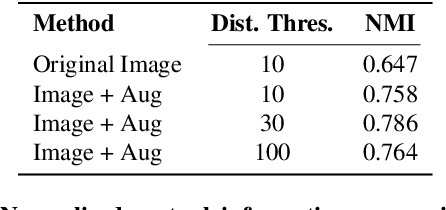Soren Pirk
3DMiner: Discovering Shapes from Large-Scale Unannotated Image Datasets
Oct 29, 2023



Abstract:We present 3DMiner -- a pipeline for mining 3D shapes from challenging large-scale unannotated image datasets. Unlike other unsupervised 3D reconstruction methods, we assume that, within a large-enough dataset, there must exist images of objects with similar shapes but varying backgrounds, textures, and viewpoints. Our approach leverages the recent advances in learning self-supervised image representations to cluster images with geometrically similar shapes and find common image correspondences between them. We then exploit these correspondences to obtain rough camera estimates as initialization for bundle-adjustment. Finally, for every image cluster, we apply a progressive bundle-adjusting reconstruction method to learn a neural occupancy field representing the underlying shape. We show that this procedure is robust to several types of errors introduced in previous steps (e.g., wrong camera poses, images containing dissimilar shapes, etc.), allowing us to obtain shape and pose annotations for images in-the-wild. When using images from Pix3D chairs, our method is capable of producing significantly better results than state-of-the-art unsupervised 3D reconstruction techniques, both quantitatively and qualitatively. Furthermore, we show how 3DMiner can be applied to in-the-wild data by reconstructing shapes present in images from the LAION-5B dataset. Project Page: https://ttchengab.github.io/3dminerOfficial
GRIP: Generating Interaction Poses Using Latent Consistency and Spatial Cues
Aug 22, 2023Abstract:Hands are dexterous and highly versatile manipulators that are central to how humans interact with objects and their environment. Consequently, modeling realistic hand-object interactions, including the subtle motion of individual fingers, is critical for applications in computer graphics, computer vision, and mixed reality. Prior work on capturing and modeling humans interacting with objects in 3D focuses on the body and object motion, often ignoring hand pose. In contrast, we introduce GRIP, a learning-based method that takes, as input, the 3D motion of the body and the object, and synthesizes realistic motion for both hands before, during, and after object interaction. As a preliminary step before synthesizing the hand motion, we first use a network, ANet, to denoise the arm motion. Then, we leverage the spatio-temporal relationship between the body and the object to extract two types of novel temporal interaction cues, and use them in a two-stage inference pipeline to generate the hand motion. In the first stage, we introduce a new approach to enforce motion temporal consistency in the latent space (LTC), and generate consistent interaction motions. In the second stage, GRIP generates refined hand poses to avoid hand-object penetrations. Given sequences of noisy body and object motion, GRIP upgrades them to include hand-object interaction. Quantitative experiments and perceptual studies demonstrate that GRIP outperforms baseline methods and generalizes to unseen objects and motions from different motion-capture datasets.
 Add to Chrome
Add to Chrome Add to Firefox
Add to Firefox Add to Edge
Add to Edge